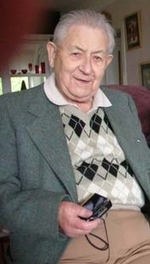Andrew Donald Booth | |
|---|---|
 Booth in 2008 | |
| Born | 11 February 1918 East Molesy, Surrey, UK [1] |
| Died | 29 November 2009 (aged 91) Sooke, Vancouver Island, British Columbia, Canada |
| Nationality | English |
| Alma mater | Jesus College |
| Known for | Booth's multiplication algorithm |
| Spouse(s) | Kathleen Booth |
| Scientific career | |
| Fields | Computer science, Physics, Electric engineering |
| Institutions | Birkbeck College, University of London, Lakehead University |
Andrew Donald Booth (11 February 1918 – 29 November 2009)[2][3] was a British electrical engineer, physicist and computer scientist, who was an early developer of the magnetic drum memory for computers.[1] He is known for Booth's multiplication algorithm.[2]
The son of Sidney Booth (died 1955) a cousin of Sir Felix Booth, he was raised in Weybridge, Surrey, and educated at Haberdashers' Aske's Boys' School. In 1937, he won a scholarship to read mathematics at Jesus College, Cambridge. Booth left Cambridge without taking a degree, having become disaffected with pure mathematics as a subject. He chose an external degree from the University of London instead, which he obtained with a first.[2]
From 1943 to 1945, Booth worked as a mathematical physicist in the X-ray team at the British Rubber Producers' Research Association (BRPRA), Welwyn Garden City, Hertfordshire, gaining his PhD in crystallography from the University of Birmingham in 1944. In 1945, he moved to Birkbeck College, University of London, where his work in the crystallography group led him to build some of the first electronic computers in the United Kingdom[4][5] including the All Purpose Electronic Computer, first installed at the British Rayon Research Association.[6] Booth founded Birkbeck's department of numerical automation and was recently named a fellow at the university. He also did early pioneering work in machine translation.[7]
Dr. Booth served as President of Lakehead University from 1972 to 1978.
Booth married mathematician and computer engineer Kathleen Hylda Valerie Britten in 1950, and had two children, Amanda and Ian;[8] between 1947 and 1953, together they produced three computing machines.
Born February 11 1918, East Molesy, Surrey, UK; early computer developer at the University of London who worked with John von Neumann; with Warren Weaver in 1946, first conceived of machine translations, and manufactured magnetic drum memories for many early computers.
Booth and his wife raised two children, Amanda, a veterinarian, and Ian, a physicist.
By: Wikipedia.org
Edited: 2021-06-18 19:35:21
Source: Wikipedia.org